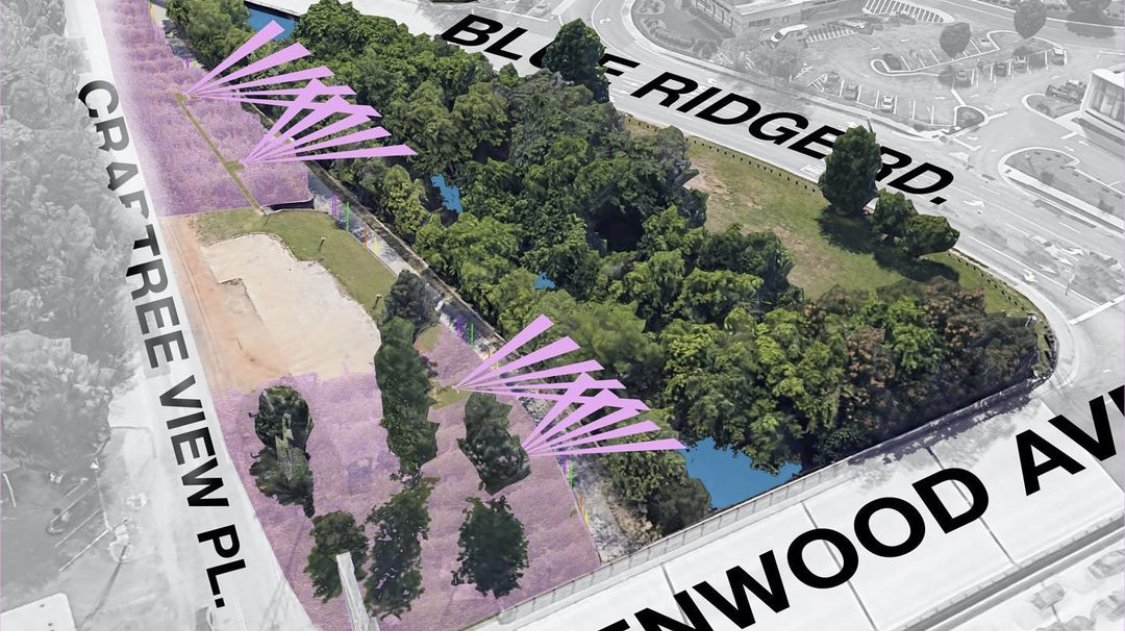
how we work
Our work involves careful consideration of place — the people and communities who occupy and use it, and the stories and natural systems that make it specific and unique.
Our projects are designed to age gracefully. We use durable, low maintenance materials and embrace the weathering process as an authentic part of the story of any particular work and site. We see nature and the environment as ever-present collaborators.
A recent award-winning project for the City of Raleigh — Alluvial Decoder — illustrates how we integrate landscape, art, and design to address the nuances of place, weaving cultural context, site analysis and data into an experience that is narrative and memorable.

case study: alluvial decoder
Alluvial Decoder is a site-specific intervention along the City of Raleigh greenway on the banks of Crabtree Creek.
Since the development of Crabtree Valley Mall in 1972, the project site has been subject to dramatic and dangerous flooding during tropical storms, hurricanes, and times of intense rainfall. City of Raleigh Stormwater and Raleigh Arts commissioned us to help educate visitors about the floodplain and the complex history of the site.
A busy greenway path runs along Crabtree Creek at the site of the project. The area is also surrounded by heavily-traveled roads. The design for the project considers encounters from the path as well as views from afar, making the project visible and accessible to both pedestrian and vehicular traffic.
©Jordan Gray
Twenty-five steel markers in the field along the creek make the magnitude of historic floods tangible for visitors and passing traffic. Environmental graphics and signage in the underpass entry decode the patterns on the flood markers and provide additional context and understanding while a reinstituted native meadow creates a natural riparian zone along the trail.
The visual language and color system is inspired by maritime signal flags, a reference to the origin of many of the named storms represented. Designed to flood, Alluvial Decoder reveals the relationships of rising stormwater to past events in real time. It serves as an experiential reminder of the hazards of development, the wonder and fury of nature, and the simple steps we might take to mitigate such challenges now and in the future.
The project has received numerous awards including the Raleigh Medal of Arts, an Editors’ Pick - Best of Design Award from The Architect’s Newspaper, Google’s Geo for Good Impact Award, Fast Company’s Innovation By Design Award (Urban Design Honorable Mention) and honors from the American Planning Association and American Institute of Architects. It was recently shortlisted for the International Award for Public Art and a Finalist for the 2024 World Architecture Festival (Global Landscape project of the Year).
©Negin Naseri
©Jordan Gray
testimonials
“So inspired and inspiring.”
– Patrick Bellew, Founder, Chief Sustainability Officer and Chairman Emeritus, Atelier Ten (UK Royal Designer for Industry, CIBSE Gold Medal recipient, Yale Architecture William Henry Bishop Visiting Professor)
”Unbelievable... I’m really memorized. Your whole effort as an artist, as an architect, as an arts person… what you are dealing with is the true sense of making change and dealing with the vulnerable situation of climate change. You are doing the best possible. This is the best possible project that you could have done.
I would (also) like to say that this is an example that (while) we architects and designers want to solve the problem - here the problem becomes the celebration. When we learn how to celebrate our pain... our challenges... that will be the true beauty of life. We must learn how to celebrate our challenges… not to solve the challenges and then celebrate. This is your achievement and I would like to thank you very much.”
– Rafiq Azam, Founder & Principal, Shatotto Architecture (six-time South Asian Architect of the Year Award recipient, ARCASIA Gold Medal Award recipient, multi-time World Architecture Festival winner)
*2024 World Architecture Festival Juror Comments
”Every now and again you come across something so simple and obvious that it makes it all look too easy. But as we know from figure skating to Newton’s Laws, this is the essence of true beauty.”
– Andrew Patterson, Founder & Director, Patterson Associates (New Zealand Gold Medal for Architecture recipient, 2023 World Architecture Festival Global Cultural Building of the Year)
First flood (one month after project install)
Markers across the creek (greenway path in background)
90 second video project overview
project partners
Raleigh Arts (client)
Raleigh Stormwater (client)
Luke Buchanan (muralist)
Cricket Forge (fabrication, installation)
Ryan Pound | RAD Graphics (signage)
Rob Stevenson | Bennett & Pless (structural engineering)
credits
videography by Jordan Gray and Lincoln Hancock
images © Keith Isaacs Photo unless otherwise noted
additional images © Negin Naseri and © Jordan Gray
designed by a gang of three
Will Belcher, William H. Dodge, Lincoln Hancock












